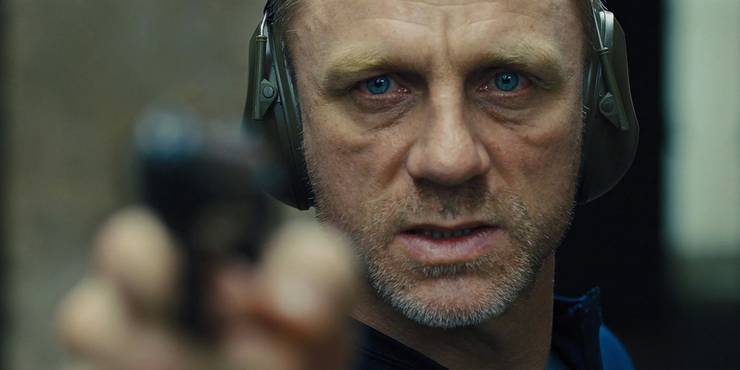Every James Bond Movie Title Meaning Explained

Here’s the meaning behind every James Bond movie title. The longest-running franchise in film history pioneered many popular aspects of spy and action movies, and the Bond saga’s distinctive titles are a calling card as unique as 007’s choice of cocktail and his license to kill. The 25th Bond movie, No Time To Die, releases in April 2020, and it continues the franchise’s dramatic flair for titles.
James Bond was created by Ian Fleming in the 1950s and the prolific author penned 14 books about his dashing secret agent, which includes 12 novels and 2 collections of short stories. The Bond movies began with 1962’s Dr. No and for the first two decades of the franchise, the films either adapted or simply borrowed the provocative titles of Fleming’s tales. After The Living Daylights in 1987, the movies had run through the bulk of Fleming’s ideas and resorted to mimicking the creator’s evocative style for Bond movie titles from 1989’s License to Kill to 2002’s Die Another Day. Curiously, despite numerous James Bond continuation novels written by John Gardner, Raymond Benson, and Anthony Horowitz, the movies don’t borrow the Fleming-like titles concocted by them. Eventually, the use of Ian Fleming’s book titles returned for the first two of Daniel Craig’s films, Casino Royale and Quantum of Solace.
So, what makes a James Bond title so unique? It boils down to an ineffable combination of drama, intrigue, a pithy play on words, and an occasional naughtiness – all aspects of the suave super spy himself – which lend themselves to being unforgettable. Additionally, there is often hidden significance behind the Bond movie titles that can be as fascinating as the world-saving adventures 007 embarks upon. Here’s what the titles of every James Bond movie mean, from the 25 “official” films and including Sean Connery’s “unofficial” 1983 comeback as 007, Never Say Never Again.
Dr. No (1962)

The first James Bond movie not only introduced Sean Connery as 007, it adapted the 6th Ian Fleming Novel, Dr. No. It’s also the first Bond movie to be named after the villain, Doctor Julius No (Joseph Wiseman), a reclusive Chinese-German scientist with metal hands who planned to disrupt the Mercury space program. In addition, Dr. No marks the first time SPECTRE is mentioned in a Bond movie as the titular villain is an agent of the villainous organization.
From Russia With Love (1963)

From Russia With Love is named after the fifth Ian Fleming novel. The title refers to Tatiana Romanova (Daniela Bianchi), a Soviet corporal and cipher clerk who is used as bait by SPECTRE to lure 007 to Istanbul with the promise of both romance and possession of the Lekter cryptography device. President John F. Kennedy also considered From Russia With Love one of his favorite novels, which boosted the popularity of Ian Fleming’s James Bond books in the United States.
Goldfinger (1964)

Goldfinger is also titled for the film’s villain, Auric Goldfinger (Gert Fröbe), who planned to irradiate the United States’ gold deposit in Fort Knox to increase the value of his own private shares. The title track, “Goldfinger”, sung by Shirley Bassey is also arguably the most iconic Bond movie theme just as Goldfinger is generally considered the most popular of Sean Connery’s James Bond movies.
Thunderball (1965)

Thunderball refers to Operation: Thunderball, the British Secret Service’s response to SPECTRE stealing two atomic missiles and threatening to launch them on major world cities. Thunderball adapts the ninth Ian Fleming Bond novel, which introduced SPECTRE’s leader Ernst Stavro Blofeld and was the start of the novels’ “Blofeld Trilogy” (although Blofeld made his movie debut in From Russia With Love).
You Only Live Twice (1967)

You Only Live Twice refers to Bond being “killed” at the start of the movie as part of an operation where 007 covertly visits Japan to discover SPECTRE’s plot to derail NASA’s space program. The film only loosely adapts Ian Fleming’s 12th Bond novel of the same name. In the book, Bond learns to compose a haiku: “You only live twice/Once when you are born/And once when you look death in the face”. However, the title song sung by Nancy Sinatra changes the lyric to “You Only Live Twice/Or so it seems/One life for yourself/And one for your dreams”.
On Her Majesty’s Secret Service (1969)

On Her Majesty’s Secret Service is an obvious reference to Bond’s employment by the British Secret Service but the title carries no greater significance in regards to the movie’s story. In the film, as in Ian Fleming’s 11th novel with the same title, James Bond (played by George Lazenby for the only time) uncovers another plot by Blofeld (Telly Savalas) while he falls in love and marries Tracy Di Vincenzo (Diana Rigg). The opening credits of On Her Majesty’s Secret Service reference the previous Connery movies to establish that Lazenby’s 007 is the direct continuation of the same character.
Diamonds Are Forever (1971)

Diamonds Are Forever loosely adapts the 4th Ian Fleming James Bond novel where 007 tracks a diamond smuggling operation. The film then takes Bond to Las Vegas to discover yet another elaborate Blofeld plot. In the context of the film, with Sean Connery returning to the role after George Lazenby’s one-off, Diamonds Are Forever also implies how indestructible James Bond has proven to be.
Live And Let Die (1973)

Live And Let Die is the second James Bond novel by Ian Fleming and it’s the first to star Roger Moore as 007, who would embody the superspy for the next decade. The title is an obvious James Bondian play on the classic aphorism “Live and let live”, which is highlighted in the lyrics to “Live And Let Die”, the chart-topping rock song recorded by Paul McCartney and Wings.
The Man With The Golden Gun (1974)

The Man With The Golden Gun refers to Scaramanga (Christopher Lee), the world’s greatest assassin who charges a million dollars to dispatch a target with his signature weapon and takes aim at 007 himself. The Man With The Golden Gun is adapted from Ian Fleming’s 13th James Bond novel, which was published posthumously.
The Spy Who Loved Me (1977)

The Spy Who Loved Me uses the title of the 10th Ian Fleming James Bond novel but it has no resemblance to the book’s story. Instead, the film’s title refers to Anya Amasova AKA Agent XXX (Barbara Bach), Bond’s Soviet equivalent, who teams up with 007 to stop a madman named Stromberg (Curd Jurgens) from sparking World War III to create a new civilization underwater.
Moonraker (1979)

Moonraker was Ian Fleming’s third James Bond novel, which was named for the Moonraker missile, Britain’s first nuclear weapon invented by the villainous Sir Hugo Drax. In the 1979 film, the Moonraker was a fleet of space shuttles owned by Drax (Michael Lonsdale), who wanted to destroy civilization on Earth, except for his handpicked, genetically ideal survivors who would live on a space station.
For Your Eyes Only (1981)

For Your Eyes Only is the title of Ian Fleming’s first collection of James Bond short stories, two of which, From A View To A Kill and Quantum of Solace, would lend their titles to later Bond movies. In the film For Your Eyes Only, the title is referenced as a stamp on a secret file given to James Bond. In addition, the movie’s Bond Girl, Melina Havelock (Carole Bouquet), told 007 that the sight of her body was “for your eyes only, darling”.
Never Say Never Again (1983)

The title Never Say Never Again is a tongue-in-cheek reference to the fact that Sean Connery returned to play James Bond one final time after claiming he would “never” again portray 007 when he retired from the role over a decade prior. The film itself is a remake of Thunderball after writer Kevin McClory, who owned the rights, got this film in production to compete with 1983’s “official” James Bond movie, Octopussy, starring Roger Moore.
Octopussy (1983)

The raunchiest James Bond title, Octopussy refers to the film’s title character (Maud Adams), an international jewel smuggler 007 tracks to India. Octopussy also has a tattoo that she refers to as “my little Octopussy”. The title, however, comes from Ian Fleming’s final collection of short stories and his Octopussy tale is about Bond hunting down a World War II veteran who stole Nazi gold.
A View To A Kill (1985)

A View To A Kill‘s title is a shortening of the title From A View To A Kill, one of the tales in Ian Fleming’s For Your Eyes Only short story collection. The film, which was Roger Moore’s final outing as 007, bears no resemblance to the short story and, instead, loosely remakes Goldfinger, with the villainous Max Zorin (Christopher Walken) trying to destroy Silicon Valley. Zorin also says the film’s title: when his henchwoman Mayday (Grace Jones) says “What a view!” as they fly over San Francisco, Zorin replies, “To a kill!”
The Living Daylights (1987)

The Living Daylights, Timothy Dalton’s debut outing as 007, takes its title from and loosely adapts Ian Fleming’s short story wherein James Bond targets a sniper only discover the sniper is a beautiful woman. This plotline comprises the first act of the film where Bond meets and saves the life of the sniper, Kara Milovy (Miriam D’Abo).
Licence To Kill (1989)

Licence to Kill is the first James Bond movie not to use the title of an Ian Fleming story, although the film’s plot contains elements of Fleming’s Live and Let Die and The Hildenbrand Rarity. The film’s title refers to Bond going rogue on a mission of vengeance and MI-6 revoking his licence to kill. In fact, the movie’s original title was Licence Revoked.
GoldenEye (1995)

The debut of Pierce Brosnan as 007, GoldenEye refers to the film’s titular doomsday weapon, a satellite that can emit a destructive EMP pulse. However, both the film and the weapon are named for Ian Fleming, who participated in Operation: GoldenEye after the Spanish Civil War. Fleming later named his estate in Jamaica GoldenEye.
Tomorrow Never Dies (1997)

The title Tomorrow Never Dies is a cheeky, James Bondian turn-of-phrase referring to the movie’s villain, Elliot Carver (Jonathan Pryce), a media magnate who created the global tragedies that his newspapers and TV networks then reported. Tomorrow was also the name of one of Carver’s newspapers. Despite the film’s title, Bond made sure Tomorrow and its owner did die.
The World Is Not Enough (1999)

The World Is Not Enough is a reference to the Bond family motto, “Orbis non sufficit”, which is Latin for “the world is not enough”. The movie’s title is uttered by James Bond when he says, “For some of us, the world is not enough” to Elektra King (Sophie Marceau).
Die Another Day (2002)

Pierce Brosnan’s 4th and final Bond movie, Die Another Day‘s title marks a double milestone as the 2oth James Bond movie which was released in 2002, the 40th anniversary of the inaugural Bond film, Dr. No. 007 utters the title in dialogue when he says, “So you live to die another day” to the villain Gustav Graves (Toby Stephens). The title also refers to the film’s opening sequence, where Bond is imprisoned and tortured in a North Korean gulag but survives so that he can die another day. Ironically, Die Another Day ended the original movie incarnation of James Bond and the lineage that lasted from Connery to Brosnan because the franchise rebooted with 2006’s Casino Royale.
Casino Royale (2006)

Daniel Craig’s debut as 007 saw the franchise reboot entirely and go back to the beginning, taking its title and plotline from Casino Royale, Ian Fleming’s first James Bond novella. The eponymous casino in Monaco is the setting of a high-stakes poker game Bond participates in which is the centerpiece event in both Fleming’s story and the blockbuster film.
Quantum of Solace (2008)

Quantum of Solace is the maligned title lifted from Ian Fleming’s short story in the For Your Eyes Only collection. In the book, “quantum of solace” is a unique turn of phrase that refers to the smallest amount of comfort a human being can give another. The film’s title refers to Quantum, a villainous organization 007 faces, which was later retconned to be part of Spectre.
Skyfall (2012)

Skyfall refers to James Bond’s childhood home, an isolated mansion in Scotland, which is a source of trauma for 007 after the deaths of his parents in a climbing accident when he was 12. In the film, Bond returns to Skyfall for a climactic showdown with the villainous Silva (Javier Bardem), where James put the demons from his past to rest.
Spectre (2015)

The title Spectre is self-explanatory: the film reintroduced the evil global terrorist organization into Daniel Craig’s Bond continuity and it also revamped James Bond’s arch-nemesis Ernst Stavro Blofeld (Christoph Waltz). Spectre retconned Blofeld into James’ adoptive brother, formerly known as Hans Oberhauer, who then reveals he was “the author of all of [Bond’s] pain” going back to Casino Royale.
No Time To Die (2020)

Expected to be Daniel Craig’s final James Bond film, some fans theorize that No Time To Die could potentially be a remake of Dr. No. The title could refer to the fact that Craig’s 007 saga is coming to a close after 14 years (the longest tenure of any actor as James Bond) – although this doesn’t necessarily mean that James Bond himself will die in the film, hence No Time To Die.
- No Time to Die/James Bond 25 (2021)Release date: Oct 08, 2021
About The Author

















